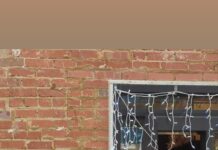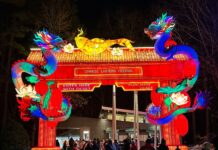
On the unusually hot summer day of August 20, the sun was beginning its descent beneath the horizon, the dusk soon to become an arena housing a clash between people and their beliefs. Walking with his comrades, Ian Broadhead arrived early to the scene as one of many protestors, his identity hidden under a hat, sunglasses and a bandana.
The bandana was the iconic Carolina Blue but featured printed bold black letters reading “SAM MUST FALL,” and three matching arrows striking down the ghostly silhouette of the statue.
The hat covered Broadhead’s head and eyes. His identity was not important, he thought. The important issue at hand was the blight everyone here was so desperately trying to remove 一 “Silent Sam.”
His eyes darted among signs and banners prepped to plaster onto the statue’s base.
“THE WHOLE WORLD IS WATCHING.”
“A WORLD WITHOUT WHITE SUPREMACY.”
“WHICH SIDE ARE YOU ON?”
“SAM MUST FALL.”
Last year’s demonstrations, though, were not the first; University of North Carolina at Chapel Hill (UNC) students and Chapel Hill citizens had long staged protest over the controversial Silent Sam.
Silent Sam was one of over 700 statues built in the South by the United Daughters of the Confederacy to honor Civil War soldiers.
The statue had been unveiled on June 2, 1913, commemorated with a speech by Confederate veteran Julian Carr, in which he infamously bragged about “horse-whipp[ing] a negro wench until her skirts hung in shreds” for insulting a white woman.
At the unveiling, Mary Lyde Hicks Williams, the President of the North Carolina division of the Daughters of the Confederacy, emphasized the soldiers behind the statue: “May [students] remember that such courage and fidelity as those ‘Boy Soldiers’ display made it possible for the fame of Lee.”
The statue seems to have given some of today’s students the “courage and fidelity” to hold true to the white supremacist beliefs underlying Silent Sam.
It was not until 1965, though, that North Carolinians examined the racial and political symbolism of the statue. Al Ribak, a student at UNC, wrote a letter to The Daily Tar Heel in 1965 entitled “Silent Sam should leave,” arguing that the statue was meant to provide “a fictitious ‘honor” for “the darkest blot on American history.”
“The existence on the UNC campus of a monument to men who were militant white supremacists and extremists of the worst kind is no less an affront to the Negro peoples and the intelligentsia than is the gaudy confederate flag-flying from the lily-white dome of Alabama’s capitol,” Ribak argued in his letter
The belief that Silent Sam should be removed strengthened as time passed and students became more aware of the harm the statue inflicted upon minority students.
In 1971, the Black Student Movement of UNC and the Afro-American Society of Chapel Hill High School protested Silent Sam in honor of two men— James Cates, an African-American man who was murdered in 1970 by a white motorcycle gang, and William Murphy, an African-American man who was killed by a police officer in 1971.
A similar protest was held again by the Black Student Movement of UNC two years later in 1973 memorializing Cates. The Movement’s Chairman, Willie Mebane, could not directly recall his involvement in the protest, but “the tension was often high, as Silent Sam was a highly visible symbol and statement that efforts at racial reconciliation would be met with strong opposition.”
That same year, UNC student Marvin Veto wrote a letter to the editor defending the statue, calling it a landmark, not a symbol of racism. Veto argued that Silent Sam stands as one of the “reminders of the shameful past of our country [which] can be found everywhere.”
The debate around the statue became inflamed again in 2003 when Professor Gerald Horne wrote a letter to the editor of The Daily Tar Heel suggesting the statue being torn down was similar to the statues of Saddam Hussein falling in Iraq.
“The monument excuses not only the racist, but the treasonous acts, and beliefs of those it purports to memorialize and their supporters still living today,” Mebane said.
The arguments protecting and defending Silent Sam continued until the recent and monumental August 2018 protest.
The protest began at six, but not ten minutes passed before tension escalated. A police officer pulled Ian Broadhead, a history major and acting protestor, aside, asking him to remove his bandana. Even with willing compliance, the policeman brought him to the court next door, Broadhead said.
Broadhead was pressed against the white wall in the hallway. The smell of sweat and fear met the nostrils in a stinging scent. The sweat and the fear did not belong to the protestors, but to the officers, he said.
Broadhead recalled police officers running in and out of the courthouse wildly, some swearing and some loudly exclaiming the supposed violence they were experiencing from the protestors. He waited patiently, head still against the wall, the chain between his handcuffs still being held, “like a kitten being grabbed by its scruff,” Broadhead said. Outside he heard the shouts of protestors.
“NEXT UP, CHARLOTTESVILLE.”
“NO MORE WHITE SUPREMACY.”
“SAM MUST FALL.”
Walking out of the courthouse with his court date in hand, joining in the march and then slipping to the other side of the street, Broadhead watched Silent Sam wrench to a tilt. The ropes fell loose as the stone met the pavement with the sound of a loud crack resonating throughout campus amongst the white noise of cheerful screams.
Biblical, symbolic, powerful. All these words came to mind as Broadhead noticed the frustrated policemen scattering around the shattered monument. This was historic, he thought. This was the power of the people.
This was not merely just a statue being ripped from its base; this was a 100-year old symbol of hatred being destroyed at its core.
Sam had fallen.











